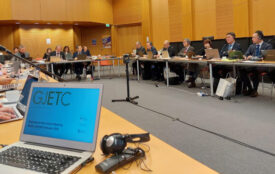How energy efficiency cuts costs for a 2-degree future
The world’s largest and fastest growing economies can help limit global warming to 2 degrees centigrade and save 2.8 trillion dollars at the same time – if they give high priority to energy efficiency.
This is the result of the study “How energy efficiency cuts costs for a 2-degree future“ recently published by the Fraunhofer Institute for Systems and Innovation Research ISI. The results will be presented on 4 December in Paris, where international climate negotiations currently take place. Fraunhofer ISI will also be contributing to three official side-events.
For the study “How energy efficiency cuts costs for a 2-degree future“ Fraunhofer ISI investigated the role of energy efficiency options in the portfolio of mitigation options in six countries and regions particularly relevant to mitigate climate change: the United States, the European Union, China, India, Brazil and Mexico. On the basis of different development pathways the scientists have addressed the issue how more energy efficiency can help to reach the internationally agreed target of limiting global warming to a maximum of two degrees centigrade at the lowest possible cost.
They have come to the conclusion that in the investigated countries additional energy efficiency measures and programs can achieve constantly increasing cost savings – up to 250 billion dollars in 2030 alone. Globally the accumulated savings would amount to a total of 2.8 trillion dollars between 2015 and 2030. An energy efficiency pathway and a more energy-intensive decarbonisation pathway that focuses primarily on eliminating carbon from energy supply, with more limited energy efficiency policies were compared. The financial savings in the “efficiency pathway” come from the reduced need for investments in new energy supply, and direct savings on energy expenses.
Dr. Jakob Wachsmuth, principal author of the report at Fraunhofer ISI, emphasizes, “What our findings show is that energy efficiency holds the key to controlling costs of limiting global warming to 2 degree. Every nation we studied benefits from some form of aggressive policies to support energy efficiency, but our research also shows that each nation should craft a strategy that reflects its domestic conditions: For instance in the buildings sector, the EU and the USA most need to catch up on thermal retrofits whereas in India it is more important to exchange inefficient air conditioning systems and promote energy efficiency in new buildings“.
While modeled results suggest significant future savings from current and new energy efficiency policies, programs and technologies, the future costs of decarbonization in China, the EU and the US have already been reduced by at least 750 billion dollars between 2015 and 2030 by energy efficiency policies adopted since 1990. Much of these gains have been realized in the transport, buildings, and industry sectors through policies such as fuel economy and appliance standards, building energy codes, and best practices in industrial energy management.
Report: „How energy efficiency cuts costs for a 2-degree future” | pdf
Source
Fraunhofer Institute for Systems and Innovation Research ISI 2015








